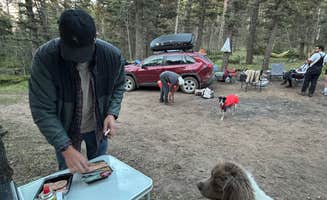Dispersed camping sites near Swink, Colorado range from river corridors to remote canyons across the southeastern plains. Most sites sit at elevations between 4,000-5,000 feet, experiencing hot summer days with temperatures regularly exceeding 90°F and cool evenings. Winter camping remains possible but requires preparation for nighttime temperatures that frequently drop below freezing from November through March.
What to do
Trail exploration at dinosaur sites: Picketwire Canyon provides access to significant paleontological resources. "Secluded area with a pretty clean bathroom. The road is a washboard for a couple miles but worth it," notes camper Tiffani H. The canyon trail leads to one of North America's largest dinosaur track collections.
Canyon hiking: Three relatively short hiking trails at Vogul Canyon showcase the region's natural features and historical sites. "This is a great spot with 3 covered picnic tables with grills. There are 3 nice, relatively short hikes to see canyon, ruins of homestead sites and stagecoach stop," reports Brian W.
Wildlife viewing: The Arkansas River corridor provides habitat for various bird species and small mammals. Spring migration periods (March-May) offer particularly rewarding wildlife observation opportunities at several wildlife management areas, including shoreline access points for birding.
What campers like
Riverside relaxation: Melon Valley State Wildlife Area offers access to the Arkansas River. "Nice and quiet from any traffic and perfect breeze from the river. Woke up to a beautiful sunrise," writes Mia W., highlighting the natural appeal despite limited amenities.
Geological features: The canyon landscapes provide unique geological formations. "The hike is easy going and very scenic. Started at 1 p.m. was back at camp by 7," reports Nick K. about Picket Wire Corrals, emphasizing the accessible nature of these natural features.
Privacy and seclusion: Many sites offer separation from urban environments. "Found a great little spot in a secluded spot of woods. Very little flat spots but we made do," states Nora S. about camping in the region, noting the trade-off between remoteness and terrain challenges.
What you should know
Permit requirements: Most wildlife areas require valid hunting or fishing licenses or habitat stamps for camping. Check Colorado Parks and Wildlife regulations before arrival as requirements change seasonally.
Road conditions: Access routes vary significantly in quality. "Found this spot after a failed attempt to head up medano pass, my rav4 just did not have the clearance and it got kinda sketchy," warns Nora S. about medano pass, highlighting accessibility challenges.
Limited facilities: Most sites lack basic amenities. "There is a vault toilet and cattle corrals here. I'm not sure it is an intended spot for camping, but if the road to Withers canyon is closed because of rain, I'm sure its reasonable to camp here," explains Vanessa M., noting the need for self-sufficiency.
Seasonal considerations: Weather impacts accessibility and comfort. During summer months, temperatures regularly exceed 90°F during daytime hours while dropping significantly at night. Spring can bring sudden storms that make dirt access roads impassable.
Tips for camping with families
Safety precautions: Wildlife encounters require proper food storage and waste management. Teach children to maintain distance from wildlife and identify potential hazards like cactus. "Only con is there is lots of cactus around," notes Nick K. about the Picket Wire area.
Educational opportunities: Lake Meredith Camping provides access to both water features and historical sites, though conditions vary. Be prepared for uneven terrain and potentially disruptive conditions as one camper noted: "If it wasn't so late and stormy, my husband and I would have moved on."
Limited shade areas: Most dispersed sites offer minimal natural shade. Bring portable shade structures during summer months, particularly for midday breaks when temperatures peak. Morning activities prove most comfortable during hot periods.
Water access points: No potable water exists at most sites. Pack sufficient water for drinking, cooking, and basic hygiene. Calculate minimum one gallon per person per day plus additional reserves for emergency situations or extended stays.
Tips from RVers
Size limitations: Most sites accommodate smaller vehicles only. "Not suitable for large rigs due to unlevel ground and very sharp approach from the east," warns Linda C. about Melon Valley State Wildlife Area, highlighting terrain constraints common to primitive camping near Swink, Colorado.
Limited level parking: Finding suitable parking requires advance planning. "This is a basic lot on the river with room for several vehicles. There isn't much level ground, but if you're able to park close to the river and parallel to it, you'll be ok," advises Chris P., offering a practical parking strategy.
Seasonal road challenges: Access roads become impassable after precipitation. Check weather forecasts before departure and have backup plans ready. Several locations remain inaccessible to standard recreational vehicles during wet conditions.



